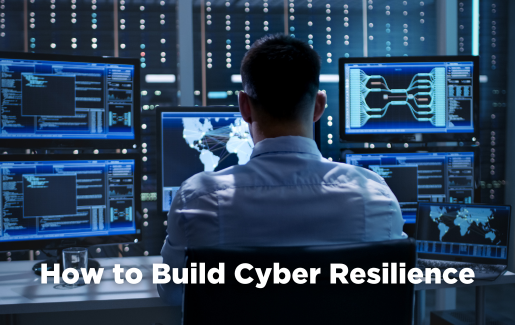 Cyber resilience is a hot topic. CompTIA’s 2024 State of Cybersecurity report identified risk management as the driving force behind many cybersecurity initiatives. Building cyber resilience is part of many risk management frameworks to help position organizations for success in the face of ever-growing and evolving cyberattacks. Even so, it can be difficult to build without a full understanding of what cyber resilience means, why it’s necessary and the obstacles to success.
Cyber resilience is a hot topic. CompTIA’s 2024 State of Cybersecurity report identified risk management as the driving force behind many cybersecurity initiatives. Building cyber resilience is part of many risk management frameworks to help position organizations for success in the face of ever-growing and evolving cyberattacks. Even so, it can be difficult to build without a full understanding of what cyber resilience means, why it’s necessary and the obstacles to success.
Cyber Resilience vs. Business Resilience
It’s important to understand the distinction between these two categories of resilience. The National Institute of Standards and Technology-Computer Security Resource Center defines cyber resilience as “the ability to anticipate, withstand, recover from and adapt to adverse conditions, stresses, attacks or compromises on systems that use or are enabled by cyber resources. Cyber resiliency is intended to enable mission or business objectives that depend on cyber resources to be achieved in a contested cyber environment.”
Cyber resilience is often considered to be a subset of business resilience because cyber resilience is necessary to build business resilience. Business resilience involves a company’s ability to respond to disruptions, adapt to unfavorable conditions and recover from those interruptions. Cyber resilience is a company’s ability to respond and recover from cyberattacks. If a company develops greater cyber resilience, that will only increase their overall business resilience.
Why You Need Cyber Resilience
Developing your cyber resilience has multiple benefits for your organization. First and foremost, cyber resilience is essential for business continuity. With a cyberattack occurring every 39 seconds, it’s inevitable that you will face an attack at some point. From a governance perspective, it also helps to ensure personal information remains protected. In turn, this helps to build trust with customers and contributes to a positive reputation.
Data loss that occurs because of an attack can also seriously impact your operations. Having a strategy in place limits the potential for interruptions. Critical damage to infrastructure can also lead to high financial loss and even catastrophic failure. Building resilience also gives you a competitive advantage because customers will have more confidence in your business.
Essential Elements of a Cyber Resilience Strategy
Your cyber resilience strategy will prepare you for quick response to attacks and minimal interruptions. Here are the essential elements of a cyber resilience strategy to consider:
- Assessment and prevention: Having a deep understanding of your technology and the potential for security gaps is an optimal starting point for any business looking to develop cyber resilience. Actively implementing preventative measures is a necessary first step towards safeguarding your systems.
- Response and recovery: Every organization needs a response and recovery plan. Being able to respond to incidents quickly and efficiently is essential for building cyber resilience.
- Adaptability and flexibility: No two incidents are the same. The ability to adapt and problem solve on the fly is critical to effective response plans.
- Education and ongoing training: Stanford University reports that nearly 90% of all data breaches are caused by human error. Building cyber resilience is never a one and done—it’s a constant evolution. You absolutely need to make consistent education and realistic exercises a part of your ongoing routine.
Common Obstacles to Cyber Resilience and How to Overcome Them
Let’s face it—there are far more examples of obstacles to cyber resilience than there are success stories. Often, it seems easier or cheaper to give in to obstacles than it does to take the time and overcome them. But, putting forth the effort will be worth it in the long run. Don’t get bogged down by these common obstacles.
Shadow IT
Shadow IT is aptly named because it is always present, but easy to ignore. The only way to anticipate gaps in your security is by having a full picture of what you need to protect. Without that comprehensive viewpoint, you will inevitably have difficulty building cyber resilience.
How to overcome shadow IT: Organizations overcome shadow IT by always keeping a full directory of your IT assets. An asset inventory is a very helpful tool for cataloguing all IT infrastructure, tools and applications, as well as documenting their dependencies and implications in the event of a breach.
Lack of Executive Support
As with most projects, it can be difficult to see cyber resilience become a success factor in your organization without the sorely needed element of executive buy-in. It’s necessary to gain the support of your leadership teams to ensure that security is being effectively and consistently enforced across all your teams.
How to overcome a lack of executive support: Executive support can be difficult to garner. If you don’t have it, that’s typically because your leadership doesn’t see the value of your initiative. To overcome a lack of support, gather metrics to demonstrate the value of your program and communicate consistently with up-to-date data. It isn’t enough to sell your idea—you have to show that it’s working overtime.
Shaky Security Culture
This one can be particularly challenging. Finding fault and laying blame is a common pitfall of cyber incidents. This leads to a shaky security culture and builds distrust among the very people you’re hoping will help you overcome those threats.
How to overcome shaky security culture: Cyber resilience is built on trust and early detection. You need to show that admitting fault and taking responsibility for mistakes isn’t demonized but is in fact encouraged and rewarded. Employees will not jump to report any mistakes if they fear repercussions from their actions, making it that much more difficult and time consuming when responding to an incident.
Insufficient Preparedness
It’s often the case that attacks catch companies completely unaware. While it is likely that you’ll eventually be the target of a cyber-attack, preparedness is the key to overcoming critical damage.
How to overcome insufficient preparedness: Being prepared doesn’t mean you have discussed every single type of permutation that a cyberattack can make. It simply means that you have developed response procedures, educated your staff and run rigorous training exercise and response scenarios. The more you practice, the better you’ll be in a real situation.
Raise Your Cyber Awareness.
Learn more about earning the CompTIA Cybersecurity Trustmark.

 Add CompTIA to your favorite RSS reader
Add CompTIA to your favorite RSS reader
.png?sfvrsn=c41fb6a0_2)
